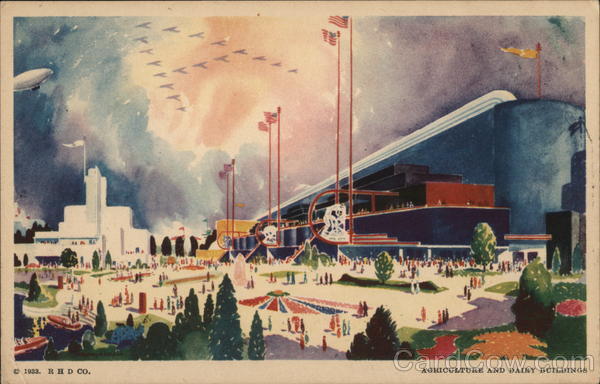Celebrating Chicago's Century Of Progress World's Fair

Table of Contents
The Dawn of a New Era: Context and Planning of the Century of Progress
The 1933 World's Fair emerged from the ashes of the Great Depression, a time of widespread economic hardship and social uncertainty. The fair’s organizers envisioned it not merely as a spectacle, but as a powerful tool to boost national morale and inspire hope for the future. The selection of Chicago as the host city was no accident; the city had a rich history of hosting successful World's Fairs, and the legacy of Daniel Burnham, the architect behind the 1893 Columbian Exposition, heavily influenced the fair's design philosophy.
- Economic challenges leading up to the fair: The Great Depression cast a long shadow over the planning stages. Securing funding and attracting exhibitors presented significant challenges.
- The role of Daniel Burnham's legacy: Burnham's vision of a grand, aesthetically pleasing city influenced the overall design and urban planning of the Century of Progress. His emphasis on beauty and functionality resonated with the fair's organizers.
- Key organizers and their contributions: The success of the fair was due to the tireless efforts of numerous individuals, including key figures in Chicago's business and political circles who spearheaded fundraising and logistics.
- The theme of "A Century of Progress" and its significance: This theme encapsulated the fair's purpose: to celebrate technological and scientific advancements over the past hundred years and to look towards a brighter future.
Architectural Marvels and Technological Innovations at the Fair
The Chicago World's Fair was a showcase of Art Deco architecture, a style characterized by streamlined forms, geometric patterns, and opulent ornamentation. The fairgrounds were transformed into a breathtaking landscape of gleaming white buildings, reflecting the spirit of modernity and progress. Beyond its aesthetic appeal, the exposition served as a platform for showcasing cutting-edge technologies.
- Description of the iconic "Sky Ride" and other notable buildings: The Sky Ride, a cable car system offering panoramic views of the fairgrounds, was a major attraction. Other iconic structures included the Hall of Science and the Federal Building.
- Examples of Art Deco architecture and its influence on Chicago's skyline: The Art Deco style prevalent at the fair left a lasting mark on Chicago's architectural landscape, influencing subsequent buildings and shaping the city's unique aesthetic.
- Showcased technologies: Television, air conditioning, etc.: The fair provided a glimpse into the future with demonstrations of emerging technologies like early television sets and air conditioning systems.
- The impact of the fair on the advancement of these technologies: The exposure these technologies received at the fair spurred further research, development, and adoption, accelerating their integration into daily life.
Cultural Impact and Lasting Legacy of the Chicago World's Fair
The Century of Progress Exposition had a profound and lasting cultural impact. It not only boosted Chicago's image as a center of innovation but also left an indelible mark on its architectural landscape and its cultural identity.
- The fair's impact on Chicago's image and tourism: The fair significantly enhanced Chicago's reputation as a dynamic and progressive city, attracting tourists and investment.
- The legacy of the fair's architectural designs: Many buildings from the fair, though temporary, influenced subsequent architectural trends and remain important examples of Art Deco design.
- The influence of the fair's exhibits on subsequent World's Fairs: The innovative approach and successful execution of the Century of Progress influenced the planning and execution of future World's Fairs.
- Long-term socio-economic effects on Chicago: The fair’s legacy extended beyond tourism, positively impacting Chicago's economy and fostering long-term growth.
The Fair's Enduring Symbolism and its Relevance Today
The themes of progress and innovation at the heart of the Chicago's Century of Progress Exposition still resonate strongly today. The fair's enduring message of hope and optimism during a time of crisis offers valuable lessons for navigating contemporary challenges.
- The fair as a symbol of hope during a time of hardship: Its ability to inspire hope during the Great Depression is a testament to the power of collective vision and human resilience.
- The enduring relevance of technological innovation and its societal impact: The fair’s emphasis on technological advancement remains highly relevant as we continue to grapple with the implications of rapid technological progress.
- Comparing the fair's optimistic vision with current technological advancements: Comparing the fair's technological displays with today's advancements helps highlight the remarkable pace of progress while also prompting reflections on societal impact.
Conclusion
Chicago's Century of Progress International Exposition stands as a pivotal moment in history – a beacon of hope during the Great Depression and a testament to human creativity and technological prowess. Its architectural marvels, innovative exhibits, and lasting cultural impact continue to resonate today. This 1933 World's Fair showcased not only technological advancements but also the indomitable spirit of a city and a nation striving for a brighter future. To further explore this fascinating chapter in Chicago's history, we encourage you to visit the museums and historical archives dedicated to the Century of Progress Exposition, explore the remaining architectural legacy in person, and delve deeper into the stories of this extraordinary event. Learn more about this fascinating chapter in Chicago's history and the enduring impact of the Chicago's Century of Progress.

Featured Posts
-
 Ztrata Pro Piraty Odchod Poslance Pexy A Jeho Kritika Strany
May 28, 2025
Ztrata Pro Piraty Odchod Poslance Pexy A Jeho Kritika Strany
May 28, 2025 -
 Is Liverpool Garnachos Next Destination After Man Utd Snub
May 28, 2025
Is Liverpool Garnachos Next Destination After Man Utd Snub
May 28, 2025 -
 Finance Loans 101 Your Complete Guide To Applying For Loans
May 28, 2025
Finance Loans 101 Your Complete Guide To Applying For Loans
May 28, 2025 -
 Welcome To Wrexham A Comprehensive Guide
May 28, 2025
Welcome To Wrexham A Comprehensive Guide
May 28, 2025 -
 Liverpool Eyeing Leagues Best Dribbler Following Player Exit Talks
May 28, 2025
Liverpool Eyeing Leagues Best Dribbler Following Player Exit Talks
May 28, 2025
Latest Posts
-
 6 Definitive Rules For Polite Office Lunches
May 31, 2025
6 Definitive Rules For Polite Office Lunches
May 31, 2025 -
 101 Samsung Tablet Is It A Better Deal Than An I Pad
May 31, 2025
101 Samsung Tablet Is It A Better Deal Than An I Pad
May 31, 2025 -
 Addressing The Crisis Drug Addicted Rats In Houston
May 31, 2025
Addressing The Crisis Drug Addicted Rats In Houston
May 31, 2025 -
 Mastering Office Lunch Etiquette 6 Essential Rules
May 31, 2025
Mastering Office Lunch Etiquette 6 Essential Rules
May 31, 2025 -
 Samsungs 101 Tablet Deal A Challenger To The I Pad
May 31, 2025
Samsungs 101 Tablet Deal A Challenger To The I Pad
May 31, 2025
